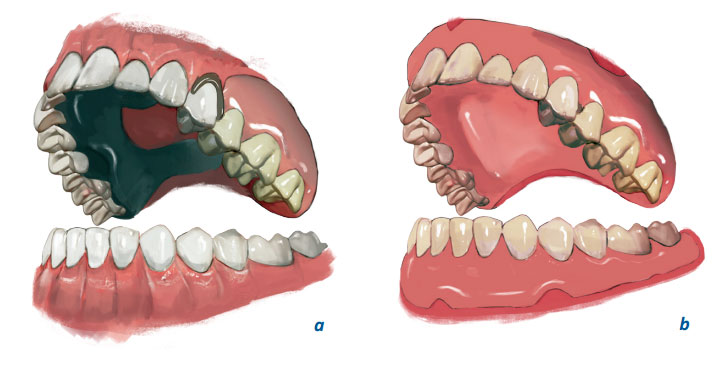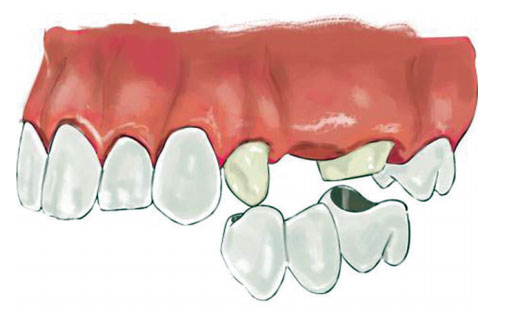1.1. Introduction to Fixed Dentures
The term prosthesis generally defines the replacement of lost organs or tissues with an artificial material as a form and function. In dentistry, treatment of the lost tooth and / or the surrounding tissues with some materials is performed with dentures.
These are classified into two groups as fixed or removable dentures, depending on whether the dentures can be placed and removed by the dentist or the patient himself. Removable dentures are called complete dentures, or full dentures if all the teeth are missing, while they are called partial dentures if some natural teeth remain. In case of one or more missing teeth, the dentures which is applied using the teeth on either side of the missing tooth is called fixed partial dentures or bridge. The restorations which will be performed in order to treat discoloration, shape and position disorders of teeth or to support bridge are called crown.
 Figure 1.1 a. b. In the gap of missing tooth/teeth, in the case where the existing tooth support is not enough to apply fixed dentures, removable partial fixed dentures containing a base on which there are some holders and pontics are used. In case that all the teeth are missing, full dentures, or complete dentures supported by the surrounding soft and hard tissues of the oral cavity are used. This kind of dentures can be placed or removed by patient himself.
Figure 1.1 a. b. In the gap of missing tooth/teeth, in the case where the existing tooth support is not enough to apply fixed dentures, removable partial fixed dentures containing a base on which there are some holders and pontics are used. In case that all the teeth are missing, full dentures, or complete dentures supported by the surrounding soft and hard tissues of the oral cavity are used. This kind of dentures can be placed or removed by patient himself.
 Figure 1.2. The restoration of missing teeth by using fixed dentures which is applied using adjacent teeth of missing tooth/teeth and can be placed and removed by the dentist by special methods is possible.
Figure 1.2. The restoration of missing teeth by using fixed dentures which is applied using adjacent teeth of missing tooth/teeth and can be placed and removed by the dentist by special methods is possible.
Functional impairments related with chewing ability, speaking ability and aesthetic are recovered with these prosthetic restoration applications.
That the missing of a tooth which have different functional ability and is in the anterior or posterior region can even cause functional impairments for chewing ability, speaking ability and aesthetic. In addition, problems may arise also in functional ability of the stomatognathic system which are connected each other. Occlusal disorders and psychological stresses are some causes of temporomandibular disorders. The most important cause of occlusal disorders is the missing of one or more teeth due to tissue loss or defects in the teeth. Fixed dentures are the prostheses which are very close to the natural tooth function and are applied very successfully with superior materials in order to treat the missing teeth and tissue loss. Furthermore, that the implants provide distal supports especially in case of free-ended partial edentulism and the restoration of one missing tooth applied on implant supports without cutting down adjacent teeth ensures fixed cron and bridge applications up to date.

Figure 1.3 a, b. In the case of insufficient dental supports, recent technology allows applying fixed restorations with implant applications replacing missing tooth/teeth. Bridges or crowns can be applied depending on the adequacy of the existing bone structure.

